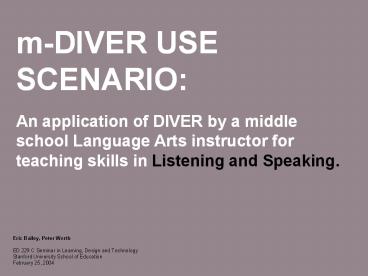m-DIVER USE SCENARIO: - PowerPoint PPT Presentation
1 / 12
Title:
m-DIVER USE SCENARIO:
Description:
m-DIVER USE SCENARIO: An application of DIVER by a middle school Language Arts instructor for teaching skills in Listening and Speaking. Eric Bailey, Peter Worth – PowerPoint PPT presentation
Number of Views:97
Avg rating:3.0/5.0
Title: m-DIVER USE SCENARIO:
1
m-DIVER USE SCENARIO
An application of DIVER by a middle school
Language Arts instructor for teaching skills in
Listening and Speaking.
Eric Bailey, Peter Worth ED 229 C Seminar in
Learning, Design and Technology Stanford
University School of Education February 25, 2004
2
Analysis Evaluation of Oral Media Comm.
1.7 Identify, analyze, and critique persuasive
techniques (e.g., promises, dares, flattery,
glittering generalities) identify logical
fallacies used in oral presentations and media
messages.
Eric Bailey, Peter Worth ED 229 C Seminar in
Learning, Design and Technology Stanford
University School of Education February 25, 2004
3
Analysis Evaluation of Oral Media Comm.
1.8 Analyze media as sources for information,
entertainment, persuasion, interpretation of
events, and transmission of culture.
Eric Bailey, Peter Worth ED 229 C Seminar in
Learning, Design and Technology Stanford
University School of Education February 25, 2004
4
The toughest thing for Tammy about teaching a 4th
5th combination was not, as she had imagined,
the double planning, teaching, and grading. Even
more difficult, she found was teaching kids
critical thinking skills when they were at such
different levels of development. She enjoyed
teaching that subject, because she believed that
functional literacy includes an understanding of
and facility with mass media, and wanted to
enhance the students learning. She believes that
functional literacy includes an understanding of
and facility with mass media.
5
She had used video clips and stills to help
students sort out the differences between types
of media, but often felt like she was telling the
kids what to think instead of teaching them to
analyze.
6
Even harder, Tammy struggles with trying to help
her kids understand media as a source for
transmission of culture. She believes that
theres too much distance between the students
and the media, and the whole class environment
makes it tough to keep her kids engaged. Her
friend, Tasha has had success with media. During
their break, she asks Tasha about her particular
teaching techniques. Tasha explains that she too
has found the transmission of culture concept
difficult to teach, but that she has had some
success while trying out interesting
technology-enhanced activities in her class. She
suggests Tammy come watch her prepare for one of
these activities during her break the following
day.
7
The next day, Tammy and Tasha meet. The two
reflect on what it means for media to transmit
culture, and ways to put that understanding into
a language that their kids would understand. They
decide to use popular music as a framework for
their ideas. Tasha and Tammy spend some time
searching the internet for the kids favorite
music videos. They decide on a new 50 Cent video
that their kids keep talking about and mimicking
during class. Then Tasha launches the m-DIVER
software she has been using to manage and conduct
her activities. Tammy observes as Tasha begins
quickly importing Quicktime, .mov, and other
video formats into m-DIVER.
8
Tasha opens the 50 Cent video in m-DIVER
Administrator. There, the two begin an analysis
of it. Using guided noticing, they isolate,
capture, and label images and sequences
representing cultural archetypes, caricatures,
values and practices. Tasha hands Tammy the
m-DIVER curricular guide and explains that it is
instrumental in helping her in completing the
next, most important, task.
9
Reading over the curriculums principles of
analysis, Tammy recognizes its use of Blooms
Taxonomy as a guide for understanding levels of
critical thinking. Meanwhile, Tasha begins
creating prompts to accompany each clip. She
explains to Tammy that different types of prompts
stimulate varying levels of thought and analysis
in her kids. Tasha prepares the class DIVE with
two sets of prompts- one for her 4th graders, the
other for her older students.
10
Since DIVER offers a tiered prompt system to make
scaffolding easy, Tammy was able to quickly enter
a few levels of prompts for each mark. Level 1
-Is there anything funny in this scene? Zoom in
on it. Okay, thats pretty basic knowledge
and identification. Level 2 - Why is it
funny? There. Thats getting closer to
comprehension and application. Level 3- Why do
you think the video maker put that
there? Alright. Thats more of an analysis.
11
Tasha explains what would happen next. Pointing
out the activities in m-DIVER curriculum, she
explains that when kids can actually focus in on
and manipulate media, they begin gaining an
objective understanding of it. She describes how
her kids might work in groups- pairing older
students with younger ones. She also describes
activities that would be useful in a computer lab
environment and shorter ones that are effective
if directed by her with a single display.
Finally, she mentions pie in the sky activities
that would be possible with touch-screen
technologies their school might never acquire,
but that were being experimented with at other
schools. Tasha saves the project and theyre done.
12
FIN
Eric Bailey, Peter Worth ED 229 C Seminar in
Learning, Design and Technology Stanford
University School of Education February 25, 2004































